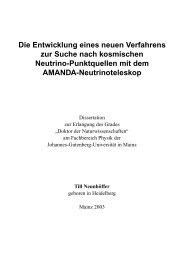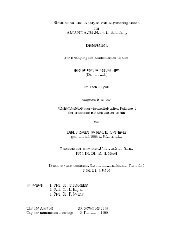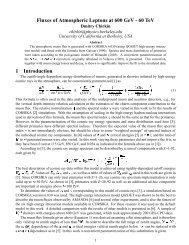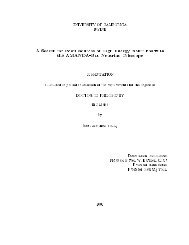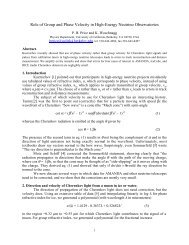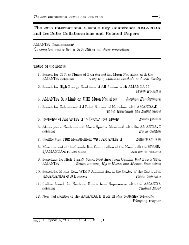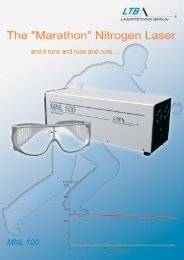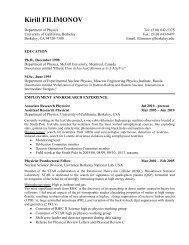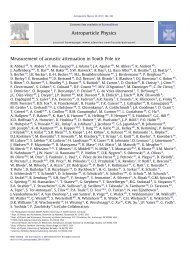Link to Fulltext
Link to Fulltext
Link to Fulltext
Create successful ePaper yourself
Turn your PDF publications into a flip-book with our unique Google optimized e-Paper software.
An important background <strong>to</strong> these events are atmospheric muons produced by cosmic rays<br />
interacting in the atmosphere. As a result, the telescope has <strong>to</strong> be buried deeply, so that the overburden<br />
of ice reduces the rate of downward muons <strong>to</strong> manageable levels. Atmospheric muons<br />
cannot traverse the Earth and so they do not produce a background of upward muons. The telescope<br />
is then designed <strong>to</strong> search for upward (or near-horizontal) muons and must be able <strong>to</strong> reject<br />
the background of downward muons by a fac<strong>to</strong>r of order ( ¢¡¤£ ) which depends on the detec<strong>to</strong>r’s<br />
depth and the optical properties of the surrounding ice. Atmospheric neutrinos produce an irreducible<br />
and isotropic background of upward muons. Fortunately, the energy spectrum of these<br />
neutrinos falls off much more steeply than the anticipated neutrino spectra of the above cosmic<br />
sources, and thus the atmospheric background should be low (relative <strong>to</strong> the source) above an<br />
energy of 1- 10 TeV, which depends on the source.<br />
A three-dimensional array of optical modules (OMs) has already been successfully deployed<br />
in several stages during the past few years, at depths between 800 and 2400 meters. An OM<br />
consists of a large (20 cm in diameter) PM housed in a glass sphere and linked <strong>to</strong> the data-taking<br />
surface electronics and power supply by a long cable. At this stage, 13 strings supporting between<br />
20 and 42 OMs each have been deployed and are taking data. The first stage (AMANDA-A)<br />
was the deployment in 1993-94 of four strings between ¥ 800–1000 m, where the air bubble<br />
density yielded a short scattering length of the Cherenkov light, but increasing with depth. It<br />
was followed by the deployment of four more strings at ¥ 1500–2000 m in 1995-96 (AMANDA-<br />
B4), assessing the better optical qualities of the ice at those depths. The size of this array was<br />
increased by the addition of six strings in 1996-97 (AMANDA-B10) and three more strings in<br />
1997-98 (AMANDA-B13), reaching down <strong>to</strong> 2400 m. This thesis will mainly concentrate on<br />
AMANDA-B4.<br />
AMANDA-B is operated in coincidence with the previously deployed detec<strong>to</strong>r at shallower<br />
depth, AMANDA-A, and also with an extensive air shower detec<strong>to</strong>r, SPASE. This provides<br />
AMANDA with a unique opportunity <strong>to</strong> compare analysis results with those from a different<br />
experiment. A Monte Carlo simulation program, LOLITA [1], has been developed at S<strong>to</strong>ckholm<br />
University, <strong>to</strong> simulate the propagation of muons in ice and the detec<strong>to</strong>r response <strong>to</strong> their<br />
Cherenkov light. It has been used both in the development of the analysis <strong>to</strong>ols and <strong>to</strong> verify<br />
results yielded by the data analysis presented here.<br />
Other detec<strong>to</strong>rs The pioneer project in this field was DUMAND [2, 3], which planned the deployment<br />
of an undersea array at 4.8 km depth outside Hawaii. A lot of their I+D and experience<br />
has been used in the design and construction of the present generation of neutrino telescopes. The<br />
project has recently been terminated.<br />
Among other similar projects already taking data is BAIKAL [4]. It consists of 6 strings with<br />
144 OMs installed in Lake Baikal at about 1100 m depth. A plan for an extension <strong>to</strong> 200 OMs<br />
is underway. Baikal has demonstrated the feasibility of doing neutrino astronomy with an array<br />
of OMs and the capability of reconstructing up and down going muons. In order <strong>to</strong> suppress a<br />
background rate of tens of kHz, they pair optical modules and use only coincidences, lowering the<br />
background <strong>to</strong> a few hundred Hz. With their present array they should identify 1-2 events/week.<br />
Currently under heavy I+D is ANTARES [5]. Their plans are <strong>to</strong> deploy an array deep in the<br />
Mediterranean, connected <strong>to</strong> the shore by an electro-optical cable. They are presently building<br />
a ’demonstra<strong>to</strong>r’, a single string <strong>to</strong> study the feasibility of such a detec<strong>to</strong>r in the sea. Site studies<br />
and the characterization of the optical properties of deep sea water have been started in the<br />
Mediterranean.<br />
NESTOR [6] is planned <strong>to</strong> be installed at 3.8 km depth in the Mediterranean. The mechanical<br />
2



